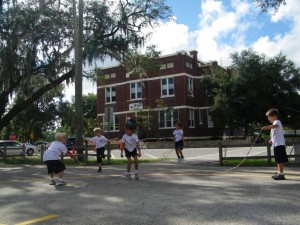Across America, Catholic schools are closing. But in San Antonio, Fla., where cows meet cul-de-sacs on the fringe of greater Tampa, St. Anthony Catholic School is getting new classrooms.

The 129-year-old, K-8 school has rebounded since it hit a Great Recession low of 153 students in 2010. It’s up to 196 students this year and aiming for 270 within a few. The comeback has quashed talk of closing, said the principal, Sister Alice Ottapurackal, and instead prompted the diocese to schedule a new building to replace aging portables.
“All this is going to be gone,” said Sister Alice, gesturing to a clutch of boxy buildings behind the stately red brick of the main school house. “It’s an amazing feeling,” she said of the rising numbers. “It’s good to see people are still interested in Catholic education.”
St. Anthony represents a fresh, Florida twist to the oft-told story of Catholic school decline. Choice and competition are part of the Sunshine State’s potentially more optimistic plot line.
Catholic school enrollment nationwide fell another 1.5 percent this year to 2,001,740, according to a report released March 22 by the National Catholic Educational Association. But in Florida, enrollment ticked up for the first time in five years – by 1 percent in K-12 and 2.7 percent counting pre-school, according to the Florida Catholic Conference.
Florida’s 217 elementary and secondary Catholic schools now enroll 82,489 students, up from 81,632 last year. The jump is even more impressive given competition from Florida’s booming charter schools, which added 48,000 students in the past two years alone.
The most visible reason for growth: Florida’s tax credit scholarship program for low-income students. The number of scholarship students in Catholic schools rose this year from 6,538 to 8,575, a 31 percent increase, according to data from Step Up For Students, which administers the program and co-hosts this blog. In some urban counties, the trend lines are even steeper. Over the last three years, the numbers in Hillsborough, which includes Tampa, leapfrogged from 167 to 431, with annual increases of 41 percent, 25 percent and 47 percent, respectively.
A few scholarships here and there are bolstering individual schools like St. Anthony. Collectively, they’re also giving hope to a school sector with a history of helping the poor and a reputation for a high bar.
“The (public) high school teachers tell us they can see the difference” with St. Anthony graduates, Sister Alice said. “Our kids are prepared.”
St. Anthony began participating in the Step Up program two years ago. It now enrolls 16 scholarship students. It also enrolls a handful of students with disabilities who use McKay vouchers.
But Catholic school supporters say it’s not just vouchers that are stabilizing enrollment.
Florida has revved up school choice more than any other state, giving more parents more power to be more picky. Catholic schools have had no choice, they say, but to respond with more focus on niches, quality and technology.
“We encourage our schools to think outside the box and not look at the traditional model of Catholic schools,” said Alberto Vazquez-Matos, superintendent of the St. Petersburg Diocese, which counts St. Anthony among its schools.
One of the high schools in the diocese is introducing an International Baccalaureate program this fall. A K-8 recently formed a partnership with a performing arts center.
“It’s okay to have a Catholic school that concentrates on performing arts, or mathematics,” Vazquez-Matos said. “That will put us into a competitive market and provide a program where parents will choose us.”
The diocese has made other changes, too. It centralized operations for its 30 schools; more aggressively pursued vouchers; stepped up marketing. It also formed a partnership with Notre Dame ACE Academies, which is working with two schools in the diocese to upgrade everything from curriculum and instruction to leadership and financial management – all in an effort to boost student performance.
In this era of choice, it’s obvious quality must be in the forefront, even as Catholic schools preserve the faith formation, character development and other traits that set them apart.
“Vouchers are not going to save (Catholic schools) if they don’t save themselves first,” Sean Kennedy, a Lexington Institute fellow who has taken a long look at what Catholic schools can learn from charters, said in a recent interview with RealClearPolicy. “Vouchers are part of the puzzle” but not a solution unto themselves, he continued.
Michael Zelenka, principal of Incarnation Catholic School in Tampa, echoed that thought. Like many other Catholic schools in Florida, his is integrating more technology in the classroom and preparing for Common Core academic standards.
“With more school choice comes almost that spirit of capitalism that says we have to continue to offer a better and better product,” Zelenka said. “We have to continue to make sure our kids are at the head of the class.”
Not far from St. Anthony, there’s another sign emerging that Catholic school leaders in Florida don’t see this year’s bump as a blip.
In Lutz, Fla., the St. Petersburg Diocese has plans for a new school for 600 kids. The roughly $8 million Mother Theresa of Calcutta Catholic School isn’t scheduled to open until fall 2014. But parents are already calling to reserve seats.


